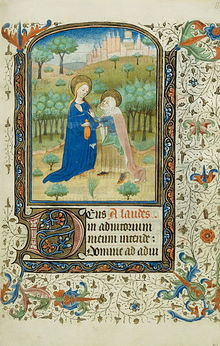Difference between revisions of "Template:DRM portals"
| Line 60: | Line 60: | ||
Have you ever tried to identify a chant melody or to find all the settings of one text incipit? Global Chant will reduce the frustration. At the [http://globalchant.org/search.php Search] link you can enter the pitches on the virtual staff. Under [http://globalchant.org/search.php Links] you can pursue data at related sites. (Some not otherwise represented here are AISCGRE, Cantus Augusta, CURSUS, LIMVP, and Melodiarium Hymnolodicum Bohamiae.) At the [http://globalchant.org/forum.php Forum] you can exchange information with other researchers. Jan Kolacek has developed this site in course of his graduate studies at Charles University, Prague. | Have you ever tried to identify a chant melody or to find all the settings of one text incipit? Global Chant will reduce the frustration. At the [http://globalchant.org/search.php Search] link you can enter the pitches on the virtual staff. Under [http://globalchant.org/search.php Links] you can pursue data at related sites. (Some not otherwise represented here are AISCGRE, Cantus Augusta, CURSUS, LIMVP, and Melodiarium Hymnolodicum Bohamiae.) At the [http://globalchant.org/forum.php Forum] you can exchange information with other researchers. Jan Kolacek has developed this site in course of his graduate studies at Charles University, Prague. | ||
| − | + | ===<big>Index to Opera and Ballet Sources Online</big>=== | |
Website: [http://atom.lib.byu.edu/obps/ Index to Opera and Ballet Sources Online] | Website: [http://atom.lib.byu.edu/obps/ Index to Opera and Ballet Sources Online] | ||
Revision as of 03:58, 26 April 2021
How does one search for musical content that cannot be located by metadata? These websites, each of which employs a different approach, will show you how.
Contents
- 1 Cantorales de la Biblioteca Nacional de Espana
- 2 Cantus Index
- 3 Dutch Song Database and Search Engine (Nederlandse Liederenbank)
- 4 E-manuscripta
- 5 Europeana: Search Engine for European (Music) Sources
- 6 Gallica
- 7 Global Chant
- 8 Index to Opera and Ballet Sources Online
- 9 The Internet Culturale
- 10 Machaut (Mirador) Viewer
- 11 Munich Digital Manuscript Collection
- 12 MusicBrainz
- 13 Musiekschatten (Music Treasures)
- 14 Open Music Library
- 15 Peachnote Music n-Gram Viewer
- 16 RISM Music Manuscript Inventory
- 17 Schoenberg Database of Manuscripts
- 18 SIMSSA
- 19 Song Helix (repertory search)
- 20 Themefinder: Music-Incipit Search
- 21 World Digital Library
Cantorales de la Biblioteca Nacional de Espana
Website: Cantorales de la Biblioteca Nacional de Espana
This search site for individual chants found in Canorales (choir books) of Spanish libraries can be searched by text or musical incipit. (Click on the musical staff and enter at least two notes to see how the music search works.) The advanced search (Busqueda avanzada) provides a dozen fields, including feast days.
Cantus Index
Website: Cantus Index
The Cantus Index, managed at the University of Waterloo (CA), is a network of 11 international projects (as of 2016) that have adopted the data format and identifier system of the Cantus Manuscript Database. These projects are devoted the creation and distribution of electronic inventories of medieval chant manuscripts. With the Cantus Index as the “hub,” the Index provides a central catalogue of chant texts and melodies for the Office and Mass. Searches in Cantus Index of both texts and melodies return results in all partner databases. The projects currently searched include these separately listed repositories:
- Antiphonale Synopticum (Harald Buchinger, Universität Regensburg, DE)
- Cantus Manuscript Database (Debra Lacoste, University of Waterloo, CA)
- Cantus Planus in Polonia (Bartosz Izbicki, Warszawa, Poland)
- Cantus Ultimus (Ichiro Fujinaga, McGill University, Montréal, CA)
- Comparatio (Claire Maître, CNRS, Paris, FR)
- Fontes Cantus Bohemiae (Jan Koláček and David Eben, Prague, CZ)
- Gregorien.info (Inga Behrendt, Masaryk University, CZ)
- Hungarian Chant Database (Gàbor Kiss, Budapest, HU)
- Musica Hispanica (Carmen Julia Guttiérez, Universidad Complutense, Madrid, ES)
- Portuguese Early Music Database (Manuel Pedro Ferreira, Lisbon, PT)
- Slovakian Early Music Database (Eva Veselovskà, Bratislava, SK)
User contributions are welcomed.
Dutch Song Database and Search Engine (Nederlandse Liederenbank)
Website: Liederenbank (Dutch Song Search Engine)
The Dutch Song database (Nederlandse Liederenbank) lists 150,000 songs in Dutch and Flemish from the middle ages through the 20th century. It includes love songs, satirical songs, Beggar songs, psalms and other religious songs, folksongs, children's songs, holiday songs, and much else. Among the other searches supported, its melodic search engine is particularly effective.
Sources include sources for all these songs are songbooks, songsheets (broadsides), song manuscripts and fieldwork recordings. The Meertens Institute (Amsterdam) compiled the database, which is now maintained by the Centre for Documentation and Research on Dutch Song. The impetus for starting the project came from the Utrecht ensemble Camerata Trajectina, which has now donated its recordings to the website. In 2014 the project was awarded the Dutch Data Prize in Humanities and Social Sciences.
E-manuscripta
Website: e-manuscripta
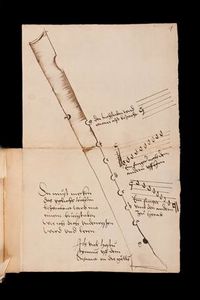
This comprehensive portal for materials in Swiss libraries serves scores, photographs, letters, pedagogical materials, and much else. The five-leaf recorder tutor (from a sixteenth-century manuscript) shown at the side represents its heterogeneity, which also extends to sixteenth-century part-books, organ tablatures, correspondence by Martin Luther, photographs of Ferruccio Busoni, and a thousand maps. It also supports user-generated transcriptions.
Europeana: Search Engine for European (Music) Sources
Website: Europeana
This umbrella site for European digitization projects covers a great deal besides music. To start, limit the search by an obvious word for music (musique, musica, Musik, etc.). This will give you an idea of how to further limit the search. Europeana is updated often. Among the items that should be visible are music prints, manuscripts, newspapers dedicated to music, sheet-music, audio files, etc. Since Europeana is an aggregation, it provides links back to the sponsoring libraries that hold the original sources. The site can be searched in many languages.
Gallica
Website: Gallica
Gallica provides access to an enormous array of digitized materials from all periods of French history and many aspects of French musical life in addition to great quantities of non-musical material. Among its highlights are illuminated manuscripts containing the poetry (much of it set to music by Guillaume Machaut), manuscripts of the operas Francesco Cavalli composed for the wedding of Louis XIV (1660-62), a very large amount of music printed in France in the eighteenth and nineteenth centuries, and important documentation for theatrical history.
Global Chant
Website: Global Chant
Have you ever tried to identify a chant melody or to find all the settings of one text incipit? Global Chant will reduce the frustration. At the Search link you can enter the pitches on the virtual staff. Under Links you can pursue data at related sites. (Some not otherwise represented here are AISCGRE, Cantus Augusta, CURSUS, LIMVP, and Melodiarium Hymnolodicum Bohamiae.) At the Forum you can exchange information with other researchers. Jan Kolacek has developed this site in course of his graduate studies at Charles University, Prague.
Index to Opera and Ballet Sources Online
Website: Index to Opera and Ballet Sources Online
The Index to Opera and Ballet Sources Online is a combined database and meta-search engine with a growing list of detailed fields, many of which are sortable. It links titles to scores, libretti, and other artifacts. It can be searched with filters for language, theater, and many other parameters of musical works that were stages. The title index relied originally on aggregators (the Braidense Raccolta Drammatica, ViFaMusik, the Internet Culturale, et al.) for most of its contents but now includes the Internet Archive. The advance search tool at atom.lib.byu.edu/opbs/advanced allows one to search within individual aggregations.
The Internet Culturale
Website: Internet Culturale
An umbrella site for digitized materials in Italian libraries. The riches of Italy's collective Internet Culturale (cultural internet) are difficult to overstate. A vast span of different kinds of graphically reproduced material will be found here. All of it is accompanied by generous supplies of metadata from cataloguing records. While one may be able to find a specific item such as an opera, one may also discover on a different spoke a list of all the works in which the singer of an aria appeared. Users can create accounts to collect previous discoveries in one place.
Machaut (Mirador) Viewer
Website: Machaut (Mirador) Viewer
The International Machaut Society takes good advantage of the open-source Mirador Viewer to enable users to compare IIIF-compliant digitized images of the music and poetry of the fourteenth-century French composer Guillaume Machaut. The tool (used in many projects outside the field of music) facilitates leafing through multiple sources on a single screen. A comprehensive (flat) listing, searchable via numerous drop-down menus, integrates additional digitized sources. The Society website contains links to further materials and projects pertinent to the composer.
Munich Digital Manuscript Collection
Website: Munich Digital Library Manuscripts
The collection of digital materials grows so rapidly that any listing of individual collections within it is doomed to be incomplete. Several projects are cooperative. The historical foundation rests on the Middle Ages and Renaissance, with much emphasis is given to religious figures and documents (e.g. at Europeana Regia). A combined search engine (http://www.digital.collections.de) for all the digitized materials in the Bavarian State Library is currently under development.
MusicBrainz
Website: MusicBrainz Database
The MusicBrainz Database is an open-source reference for recordings providing relational searches for artists, releases, recordings, works, labels, and connections between them. Users can annotate, tag, and rate individual items. This open-source database is downloadable. The host MetaBrainz Foundation offers a sliding scale of memberships progressing from academic to commercial.
Musiekschatten (Music Treasures)
Website: Muziekschatten (Music Treasures)
This archive of Netherlands Radio sheet music (Hilversum NL) contains nearly 450,000 scores of classical, light, and popular music (including manuscripts) played on Dutch radio and television since the 1920's. All of the 65,000 digitised titles can be viewed online. The WWII and Salon music-collections can be downloaded in PDF-format, while other parts of the digitised collection can be downloaded only by members (at € 20 p.a.). (Most holdings are under copyright.) The website is based on Linked Open Data (https://data.muziekschatten.nl/som/) and is in Dutch. Good starting points are the general search page (https://www.muziekschatten.nl/search) and the genres page.
Open Music Library
Website: Open Music Library: Closed 26 May 2020
Alexander Street's Open Music Music interleaved open-access and licensed-access materials (digitized scores, recordings, and basic descriptive materials) into a very large aggregation of third-party repositories. Even with restricted access to many recordings, the sheer size of the collection was impressive.
Peachnote Music n-Gram Viewer
Website: Peachnote n-Gram Viewer
This MIDI-based search system developed by Vladimir Vero plumbs a number of score aggregations, such as ISMLP to produce a general overview of short melodic phrases.
RISM Music Manuscript Inventory
Website: RISM Music Manuscript Inventory
This inventory of musical manuscripts in roughly 60 countries was begun in 1952. It is still growing (under the management of the Répertoire International des Sources Musicales). Coordinated cataloging in based at the RISM Zantralredaktion in Frankfurt, database management and processing at the Berlin State Library, and online implementation at the Bavarian State Library, Munich. RISM's numerous merits are easily discovered through in use. A RISM blog keeps registered users informed of current activities. RISM has working groups on most continents. Much material currently contained in RISM books will (with updating) find its way online over the coming years. Those interested in contributing to RISM's efforts may contact a local representative by looking here. Other RISM cataloguing projects are in transition to online presentations. One of them (A1: Printed anthologies of music before 1800) are now integrated in the RISM OPAC (online catalogue sited above). Several country-specific websites sited below offer alternative organizations and search tools for holdings. Some also include related materials or an expanded date range.
RISM France (RISM FR)
Website: [http://neuma.huma-num.fr/corpus/rism RISM France (RISM FR)
RISM France, under the direction of Laurence Decobert, is currently cataloguing music manuscripts up to 1800 in the Bibiliothèque Nationale de France. Holdings are particularly rich in works by Joseph and Michael Haydn, Chr. W. Gluck, Fr-J. Gossec, and J-Ph. Rameau. At present close to 1,350 manuscripts have been entered. Entries have links to several formats including MIDI files (and displays) of musical incipits.
RISM Ireland (RISM IE)
Website: [http://www.rism-ie.org/ RISM Ireland (RISM IE)
The Society of Musicology in Ireland (Eire) is the sponsor of this cataloging initiative. Its search tools are modeled on those of the UK site. At present works by 265 composers are represented. Associated collections with listings in progress include Music in the Irish Country House and Music in the National Library of Ireland.
RISM Switzerland (RISM CH)
Website: RISM Switzerland
The RISM Switzerland is the Swiss database of the Repertoire International des Sources Musicales (http://www.rism.info). This database contains additional material that is not listed in the international database (http://opac.rism.info), including sources from the 19th and 20th century.
RISM United Kingdom (RISM UK)
Website: RISM United Kingdom (RISM UK)
The United Kingdom RISM site has a number of special features: cross-links with Early Music Online; an impressive image gallery, useful for quick comparison of handwriting and paper; a lookup table for places of publication; and useful collection-level clusters of indexing. UK manuscripts were the earliest sources to be catalogued by RISM, and the depth of information reflects more than 50 years of accrual. The newly revised site takes advantage of important modernization features.
Schoenberg Database of Manuscripts
Website: Schoenberg Database of Manuscripts
This project of the Schoenberg Institute of Manuscript Studies at the University of Pennsylvania is for medieval studies what RISM is for music studies: It provides a comprehensive inventory of manuscripts up to the year 1600. Listings can currently be focused on any of 26 categories of description including date, place, language, library, provenance, liturgical use, vendor, artist, and many physical descriptors. Within each category searches can be narrowed by the same and similar terms. Although many of the items of musical relevance listed here may appear in DIAMM and other inventories, much of the information appears to be complementary. Although no links to digitized sources are given, the database has the inherent value of providing a rapid impression of the prevalence and/or spread of certain kinds of materials. As one example, almost 15,000 Books of Hours are listed. The advanced search feature is elegantly articulated to support with myriad text and numeric search combinations. The beta version has been online since August 2016. Periodic uploads are planned.
SIMSSA
Website: SIMSSA
The Single Interface for Music Score Searching and Analysis project (SIMSSA), based at McGill University, is teaching computers to recognize the musical symbols in digital images of musical scores. Scans of music prints and manuscripts are processed, and their contents (both text and music) are entered into a searchable format that can be studied, analyzed, and performed. Projects include Cantus Ultimus, the searchable Liber Usualis, and Elvis- the Electronic Locator of Vertical Interval Successions (ELVIS).
Song Helix (repertory search)
Website: Song Helix
Song Helix is a comprehensive art song database site for researching for vocal repertory (a) for a specific voice and (b) in as many manifestations as can be found online. These include scores, lyrics, digitized images, poetic themes, and audio renditions, accompanied by various metadata fields such as vocal range, original key, original language, and the contributing entity. Caveat lector: citations may lead to public-domain or commercial sources. Developed and maintained by the University of Utah.
Themefinder: Music-Incipit Search
Website: Themefinder
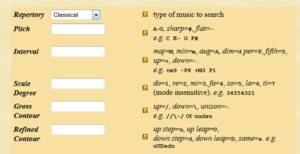
The Themefinder search engine was prototyped at CCARH in 1996 by David Huron, Andreas Kornstädt, and Walter B. Hewlett. A large number of Stanford University students including Unjung Kim and Leigh VanHandel plus visiting students including Bret Aarden participated in its early development. The search engine was originally developed to study user behavior. Over the intervening years it has been used for a large statistical study of search-efficiency. The current search engine was built and is maintained by Craig Stuart Sapp.
Themefinder contains several repertories, most of which are publicly viewable and searchable. The principal repertories are Folk, Classical, and Renaissance. Although more than 100,000 incipits and associated metadata are present in the database, users may select just one. "Hits" satisfying search-criteria can be collected on the Themefinder Clipboard and can be exported.
Incipits can be searched at five points on a continuing from the most specific to the fuzziest. Filter for meter, mode, and key may be used. MIDI files are available for each entry. Help menus are available at the website. Those interested in contributing an encoded repertory to Themefinder should describe the existing repertory and format in a query letter.
Related literature: "Search-Effectiveness Measures for Symbolic Music Queries in Very Large Databases" (Craig Stuart Sapp, Yi-Wen Liu, and Eleanor Selfridge-Field, ISMIR Proceedings 2004)
World Digital Library
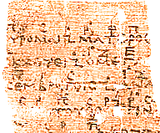
Website: World Digital Library
This UNESCO-sponsored listing of digitized sources includes a number of significant musical works in single-item digitizations. The first chorus of Euripedes' Orestes (408 BCE, from the Austrian National Library) represents the oldest contribution found here. Although the source is necessarily deteriorated, vocal and instrumental symbols can be seen within it.
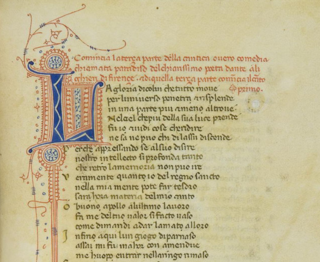
Other WDL holdings include numerous sacred vocal works from the Ars Nova and Renaissance, German operettas, and twentieth-century sheet music. More than 2,700 historical maps from all parts of the world, a handful of treatises on music and music theory (including later colored drawings of St. Jerome's "Instruments of Hieronymous" (before 420 CE), and a seventeenth-century manual on the Chinese zither (quin) are found among a lengthy list of other holdings useful to music scholars.
